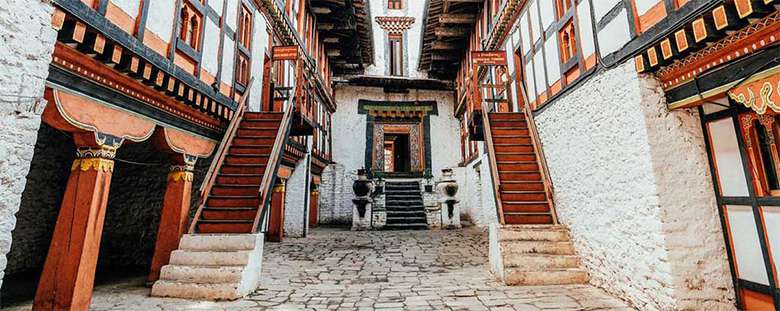

Jakar Dzong is perched on a ridge overlooking Choekar Valley of Bumthang, above the village of Jakar. The Drukpa Kagyu teachings were brought to Bhutan by Lam Ngagi Wangchuk, who is regarded as having built the foundation for Jakar Dzong, the country’s biggest dzong. Yuelay Namgyal Dzong is the official name of Jakar Dzong, which was given in recognition of the victory over the forces of Tibetan monarch Phuntsho Namgyal. After the Zhabdrung had firmly established his authority, the dzong was upgraded in 1647. The term bjakhab, which means “white bird,” is the source of the name Jakar.
Nestled amidst the lush coniferous forest, the present structure of Jakar Dzong was built in 1667 with a boundary of 1500mt. Tourists can get the sight of the white-washed wall of Jakar Dzong from the town itself.
Like the other dzong of Bhutan, Jakar Dzong has its own astounding legend about its formation. As per the legend, when the lamas gathered in just about 1549 to choose a location for a monastery, a big white bird suddenly rose in the air and settled on a spur of a hill which was taken to imply an essential signal, and the hill was selected as the place for a monastery and for Jakar Dzong, which generally decodes as ‘castle of the white bird’. Thus the name Jakar originates from the word bjakhab, meaning “white bird” and Zhabdrung’s great-grandfather, Ngagi Wangchuck, founded the monastery.
The elegant and gigantic structure of Jakar Dzong has fascinated many travelers. A stone pathway through the luxuriant forest takes the tourist toward Jakar Dzong. After reaching dzong tourists can notice the unique feature of Jakar Dzong. An unusual part here is that the utse (central tower) is situated on an outside wall, so there is no way to circumambulate it. Jakar Dzong’s interior is quite simple compared to other dzong and monasteries of Bhutan.
Besides the daunting towers and large courtyard, there is a walled passageway from the dzong which leads the visitors down the hill to a nearby spring a characteristic that made sure water could be acquired in the event of a long cordon. To dwell in the stony pathway surrounding the dzong lets the visitor feel the lingering essence of the ancient ere along with the tranquil ambiance.
The serene ambiance and simple yet complex architecture of Jakar Dzong have made it a favored destination of Bumthang Valley. Take a stroll on the stony pathway while listening to the alluring sound of chanting prayers while feasting your eyes on the scenically blessed views of the adjacent valley.
Have a look at the detailed transportation options available to reach Jakar Dzong-
By Train: The New Jalpaiguri Railway Station is the closest train station to Jakar, and a taxi can take you there.
By Air: One of the greatest methods to get to the town of Jakar is via air. Simply fly to Bumthang Domestic Airport from your closest airport, where you may pick up a cab to transport you to Jakar.
By Vehicle: You can choose any state transportation option that departs from the adjacent Phuentsholing border to travel to Jakar by road.
Although this Buddhist Dzong is open all year round, it is best to visit Bhutan from May to August when the weather is warmest. There is no more stunning view than seeing this fortress in winter among the snow if you do not mind the exceptionally hard winters of this mountainous nation.
Quick Enquiry